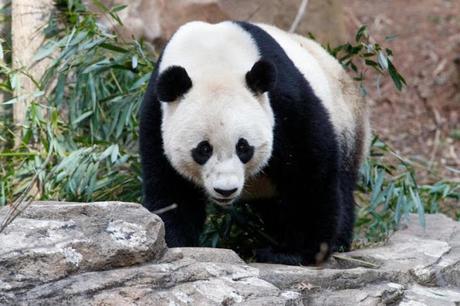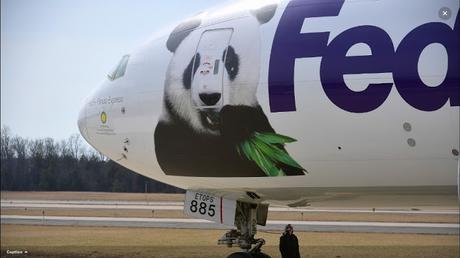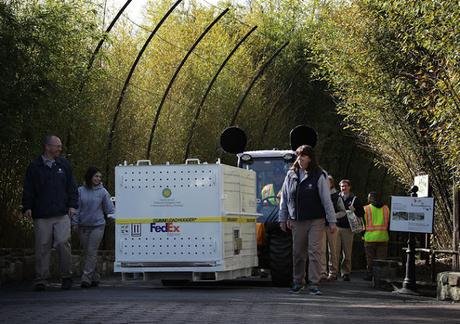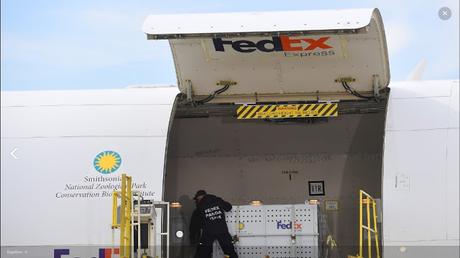 Chinese
Ambassador to the US Cui Tiankai once called Bao Bao the second Chinese
ambassador in Washington. That panda is
in news ! The giant panda (Ailuropoda melanoleuca) is a bear
native to south central China. Easily recognizable
by the large, distinctive black patches around its eyes, over the ears, and
across its round body, its diet is over
99% bamboo. The giant panda lives in a few mountain ranges in central China,
mainly in Sichuan province, but also in neighbouring Shaanxi and Gansu.
A few months ago, the World’s
oldest panda in captivity was put down at the Hong Kong theme park where she
lived, because her health had deteriorated. Ocean Park stated that a veterinarian euthanised
38-year-old Jia Jia to prevent further suffering and for ethical reasons. Guinness
World Records recognised Jia Jia as the oldest giant panda to live in
captivity. The average lifespan for a panda in the wild is 18 to 20 years,
while in captivity it is 30, according to Guinness. Born in the wild, Jia Jia
was taken at a wildlife reserve’s breeding center in Sichuan province, central
China, in 1980, when she was about two. Jia Jia and another panda, An An, were
given to Hong Kong as a gift from Beijing in 1999, on the second anniversary of
the city’s handover from Britain to China.
This post is more about ‘bao bao’, a three-year-old giant panda who has called the Smithsonian’s national zoo in Washington home since her birth in 2013, departing from Dulles airport this afternoon on a one-way trip to China to join a panda breeding program. China’s ambassador to the US Cui Tiankai was at the zoo to receive the panda, who will travel with a keeper and veterinarian for company on the 16-hour nonstop flight to Chengdu. Bao Bao’s journey began in a crate loaded onto a Fedex truck also travels with a supply of snacks including 55lbs (25kg) of bamboo, 5lbs (2kg) of apples and 2lbs (1kg) of sweet potatoes.
Chinese
Ambassador to the US Cui Tiankai once called Bao Bao the second Chinese
ambassador in Washington. That panda is
in news ! The giant panda (Ailuropoda melanoleuca) is a bear
native to south central China. Easily recognizable
by the large, distinctive black patches around its eyes, over the ears, and
across its round body, its diet is over
99% bamboo. The giant panda lives in a few mountain ranges in central China,
mainly in Sichuan province, but also in neighbouring Shaanxi and Gansu.
A few months ago, the World’s
oldest panda in captivity was put down at the Hong Kong theme park where she
lived, because her health had deteriorated. Ocean Park stated that a veterinarian euthanised
38-year-old Jia Jia to prevent further suffering and for ethical reasons. Guinness
World Records recognised Jia Jia as the oldest giant panda to live in
captivity. The average lifespan for a panda in the wild is 18 to 20 years,
while in captivity it is 30, according to Guinness. Born in the wild, Jia Jia
was taken at a wildlife reserve’s breeding center in Sichuan province, central
China, in 1980, when she was about two. Jia Jia and another panda, An An, were
given to Hong Kong as a gift from Beijing in 1999, on the second anniversary of
the city’s handover from Britain to China.
This post is more about ‘bao bao’, a three-year-old giant panda who has called the Smithsonian’s national zoo in Washington home since her birth in 2013, departing from Dulles airport this afternoon on a one-way trip to China to join a panda breeding program. China’s ambassador to the US Cui Tiankai was at the zoo to receive the panda, who will travel with a keeper and veterinarian for company on the 16-hour nonstop flight to Chengdu. Bao Bao’s journey began in a crate loaded onto a Fedex truck also travels with a supply of snacks including 55lbs (25kg) of bamboo, 5lbs (2kg) of apples and 2lbs (1kg) of sweet potatoes.

Bao Bao, whose personality is described as “very independent”, like a domestic cat, was then loaded aboard a specially chartered FedEx plane – the “Panda Express”– in a large box marked “one panda”. The plane departed around 2pm, an event covered on live TV and on the zoo’s Facebook page. “Most of the flight, we hope she’s going to eat,” panda keeper and travel companion Marty Dearie told the Associated Press. Dearie added that pandas like to spend 13-16 hours a day eating. The national zoo explained that Bao Bao is traveling now because it’s better for pandas to travel in the winter months, when it is cool.
 The cub departed Tuesday
on a 16-hour, nonstop flight from Dulles International Airport to Chengdu,
China. – media reports suggests that it
has landed in China about a couple of hours back [22.02.17 @ 07.30 IST]. Bao Bao will eventually join a panda breeding
program. As part of the National Zoo’s cooperative breeding agreement with the
China Wildlife Conservation Association, all cubs born at the zoo move must
move back to China by the time they turn 4 years old. Bao Bao will turn 4 on
Aug. 23, 2017. The return of Bao Bao continues a tradition that began when
China gave the national zoo a pair of pandas, Ling-Ling and Hsing-Hsing,
following Richard Nixon’s historic trip to the country in 1972. The pair had
five cubs, but none survived. Mei Xiang and Tian Tian are the zoo’s second
panda pair. Under the terms of the agreement, the US pays China $10m for a
renewable 10-year lease on the couple.
The cub departed Tuesday
on a 16-hour, nonstop flight from Dulles International Airport to Chengdu,
China. – media reports suggests that it
has landed in China about a couple of hours back [22.02.17 @ 07.30 IST]. Bao Bao will eventually join a panda breeding
program. As part of the National Zoo’s cooperative breeding agreement with the
China Wildlife Conservation Association, all cubs born at the zoo move must
move back to China by the time they turn 4 years old. Bao Bao will turn 4 on
Aug. 23, 2017. The return of Bao Bao continues a tradition that began when
China gave the national zoo a pair of pandas, Ling-Ling and Hsing-Hsing,
following Richard Nixon’s historic trip to the country in 1972. The pair had
five cubs, but none survived. Mei Xiang and Tian Tian are the zoo’s second
panda pair. Under the terms of the agreement, the US pays China $10m for a
renewable 10-year lease on the couple.
 Bao Bao, who currently
weighs around 200lbs (90kg), has been a central attraction at the national zoo
since her birth in August 2013. Her departure leaves the zoo with three
remaining pandas. Zoo director Dennis Kelly called Bao Bao’s departure a
“really bittersweet day” for the institution. “While it represents a huge
success, we’ve become so fond of Bao Bao,” he told the Washington Post. “We’re
going to miss her so much.”
A total of four US zoos
have pandas on loan from China. In addition to Bao Bao, the US sent two female
twin pandas, Mei Lun and Mei Huan, from Atlanta zoo to China in November last
year. That leaves a dozen pandas remaining in the US: four in Atlanta, three in
Washington, three in San Diego and two in Memphis.
But – there would
always be difference of opinion on captive breeding programmes rather than
protecting them in the wild. A zoo in
northern Japan has culled 57 of its snow monkeys by lethal injection after
discovering they carried the genes of an "invasive alien species". Takagoyama
Nature Zoo in Chiba said DNA testing showed the monkeys had been crossbred with
the rhesus macaque. The non-indigenous rhesus macaque is banned under Japanese
law. A local official said they had to be killed to protect the native
environment.
Japanese
macaques, commonly known as snow monkeys, are native to Japan and are one of
the country's major tourist attractions. Japan prohibits the possession and
transport of invasive species, including crossbreeds. An official from the
Office for Alien Species Management, part of the country's environment
ministry, told local media that the culling was unavoidable because there were
fears they might escape and reproduce in the wild. Another spokesman for conservation group WWF Japan
told AFP news agency that invasive species cause problems "because they
get mixed in with indigenous animals and threaten the natural environment and
ecosystem".
With regards – S.
Sampathkumar
Bao Bao, who currently
weighs around 200lbs (90kg), has been a central attraction at the national zoo
since her birth in August 2013. Her departure leaves the zoo with three
remaining pandas. Zoo director Dennis Kelly called Bao Bao’s departure a
“really bittersweet day” for the institution. “While it represents a huge
success, we’ve become so fond of Bao Bao,” he told the Washington Post. “We’re
going to miss her so much.”
A total of four US zoos
have pandas on loan from China. In addition to Bao Bao, the US sent two female
twin pandas, Mei Lun and Mei Huan, from Atlanta zoo to China in November last
year. That leaves a dozen pandas remaining in the US: four in Atlanta, three in
Washington, three in San Diego and two in Memphis.
But – there would
always be difference of opinion on captive breeding programmes rather than
protecting them in the wild. A zoo in
northern Japan has culled 57 of its snow monkeys by lethal injection after
discovering they carried the genes of an "invasive alien species". Takagoyama
Nature Zoo in Chiba said DNA testing showed the monkeys had been crossbred with
the rhesus macaque. The non-indigenous rhesus macaque is banned under Japanese
law. A local official said they had to be killed to protect the native
environment.
Japanese
macaques, commonly known as snow monkeys, are native to Japan and are one of
the country's major tourist attractions. Japan prohibits the possession and
transport of invasive species, including crossbreeds. An official from the
Office for Alien Species Management, part of the country's environment
ministry, told local media that the culling was unavoidable because there were
fears they might escape and reproduce in the wild. Another spokesman for conservation group WWF Japan
told AFP news agency that invasive species cause problems "because they
get mixed in with indigenous animals and threaten the natural environment and
ecosystem".
With regards – S.
Sampathkumar
22nd Feb 2017.

